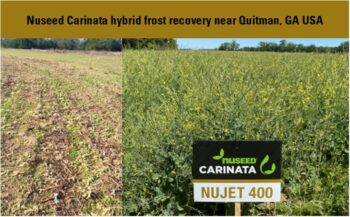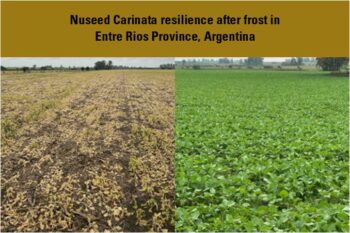Cold temperatures proved hybrid vigor, and advanced genetics.
Cover crops are ideal for improving soil, sequestering carbon as they grow over winter and reducing erosion and carbon loss. What’s not ideal? The weather between main crop rotations when cover crops are grown. Because of adverse conditions typically the cover crop return-on-investment expectation is solely the soil health benefits for the following main crop.
However, Nuseed Carinata is a new contract cover crop that is produced using certified sustainable farming practices and grows well when weather is too harsh for main crop production. Carinata is harvested for its oilseed and additional farm income, and the remaining biomass is returned to the soil surface. Carinata grain is crushed to extract lower carbon oil and supply a meal co-product for animal feed.
Frost resilience is critical to expanding Nuseed Carinata hectares to more regions in both hemispheres to help meet the rapidly growing feedstock demand for sustainable aviation fuels (SAF) and other sectors working to decarbonize by replacing fossil fuels to reduce emissions.
The harvested cover crop’s rebound after freeze events in both the Southern U.S. and Argentina demonstrates the agronomic advancement Nuseed Carinata R&D experts have been able to achieve through the new commercial hybrid Nujet 400.
The cold weather also provided the Nuseed Carinata R&D team in Argentina a chance to evaluate new Carinata lines for cold hardiness in real-life conditions. The selections made within one of the key growing regions and under realistic conditions will help to further understand and advance frost tolerance and other important agronomic traits that will be introduced over the coming years.
Coming back to life after a once in a 40-year freeze
“In Florida and Georgia, the resilience of Nuseed Carinata was so dramatic, some in our R&D circles started describing it as the Lazarus effect. Many fields we thought were dead, came back to life and resulted in a successful harvest,” said Logan Dyer, the local Nuseed Carinata research agronomist.
After three days of below 32°F, said to be a once in 40-year freeze event, the average harvested cover crop was approximately 25 bushels per acre. Initially an unwelcome challenge in the first year of commercial introduction in the Southern United States turned into an opportunity to prove the frost resilience of the world’s first Carinata hybrid. Nuseed Carinata’s potential in the “cover crop” window between main crop rotations within currently planned production regions was demonstrated. The results were encouraging for future R&D into potential production expansion north to gain more cover crop acres in the Southern United States.

Argentina freeze enables frost resilience selections in breeding pipeline
You might think a freeze event at the Nuseed Carinata research trials near the Nuseed Innovation Center in Venado Tuerto, Argentina would be a disappointing set back. However, the saying adversity makes for opportunity stands true. “Our R&D team in Argentina identified and characterized unique lines within our breeding program that survived and rapidly recovered from the freeze event and are now able to introduce them into our hybrid pipeline globally,” explained Dr. Rick Bennett, Nuseed Carinata Global Plant Breeding Leader.
Breeding lines that bounced back from at least seven hours at -7° C at the Innovation Center are now being utilized in a crossing program to develop superior frost tolerant parental line materials, coupled simultaneously with molecular marker identification for this trait. The very best new hybrid combinations resulting from this effort will advance within the Nuseed Carinata breeding program.

Nuseed’s Carinata R&D Pipeline
Given the harsh conditions between main crop rotations when Nuseed Carinata is grown, one of the main R&D priorities is to continue to improve frost resilience levels within elite Carinata hybrid genetics. In combination with frost, drought and saline soil resilience, imidazolinone (ALS) herbicide resistance will provide improved in-crop weed control options as well as tolerance to residual imidazolinone based herbicides that were used in previous crops. Elite hybrids also aim to increase yield potential in modest synthetic nitrogen application levels, with high (>44%) oil content in the grain. These key agronomic management advancements along with many others will increase potential Nuseed Carinata production acres and provide a high value cover crop for growers in these regions.
Nuseed R&D teams and facilities in Australia, Europe, North America and South America are working towards rapid production expansion to help meet the current lower carbon feedstock global demand currently outpacing supply. Also on the R&D radar – further studies in soil carbon to improve growing conditions. Soil studies with the University of Buenos Aires are underway.

